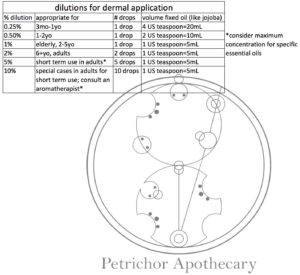Aromatherapy for natural families
by Shannon E. Becker
Aromatherapy has become an integral part of my life, which led to my further education as a certified aromatherapist. My science background is in Cell Biology, and soon I will finish my PhD program. It’s an exciting and nerve-wracking time. Likewise, pregnancy is is one of those times in your life where you are excited, scared, curious, and searching for ways to make safe choices. Knowing that you can help your family and yourself brings so much relief, but it’s very hard to determine what is the correct information sometimes.
As aromatherapy has gained popularity, many enthusiasts have started learning from aromatherapy schools, earning certifications and continuing education, as well as learning alongside veteran aromatherapists. However, there are many who have learned about essential oil use from those who have not been well educated. This approach leads to passing along unsafe practices, and unfortunately, these well-meaning people simply do not know they are promoting unsafe uses.
I’ve written extensively (as have other aromatherapists) about how the two big mid-level-marketing (MLM) companies who pass along incorrect information to their wellness advocates. Recently, the FDA has warned both companies to cease providing marketing information that promotes essential oil use to treat a medical condition, to replace medications, and otherwise use language that classifies their products as medicine or medical devices. If this language is used, essential oils fall into the drug category, and the FDA requires approval just like any given medication.
This post will not focus on the legality of FDA classifications, but will instead be about what is and what is not safe for kids, newborns, pregnant women, and nursing women. In my experience, many pregnant women seek help with relaxation, mental clarity, physical discomfort, and rest. Mothers ask me often about comforting little ones with colds, bruises, or restlessness. Aromatherapy can help address all these things, but it is important to make sure essential oils are appropriate for each individual.
Considerations for essential oil safety involve underlying medical conditions, medications being taken, age of the client, and especially the proper dilution of essential oils when used dermally. Some special groups of people who require very dilute blends include elderly women/men, young children, pregnant women, and nursing women. Medications such as blood thinners mean that essential oils containing chemical constituents that have been shown to also thin the blood should not be used. As such, wintergreen essential oil should be used very cautiously. Many MLM blends promoted for joint pain contain wintergreen essential oil, as do some over the counter muscle rubs. Unless the person selling these blends is aware of the safety of wintergreen essential oil usage, with the best intentions, they will likely suggest an inappropriate use.
As an accompaniment to my interview with Lori Isenstadt of the All About Breastfeeding podcast, I wanted to compile an easy to follow guide. Please feel free to contact me for further explanation of usage, and other aromatherapy concerns at shannon @ petrichorapothecary.com (delete the spaces to send). I also am putting together a dilution chart. Something important to know is that depending on the size of the hole in the restrictor cap, the volume in a drop of essential oil will vary. In my practice (and my academic lab) I use pipettes to be sure I have a precise volume, however, I recognize most home users may not want to buy them. See the end of this post for links to Amazon items I like, such as the disposable pipettes, gloves, and mixing bottles.
QUICK TIPS
- The most effective method for using essential oils is via inhalation. You can use essential oils in a diffuser, dropped onto diffuser jewelry, dropped onto clay medallions, used a plastic inhaler, or simply dropped onto tissues nearby. It is also the safest, and is the preferred method for use with children under 6yo.
- When using essential oils to address specific regions of the body, dermal applications are appropriate. Essential oils must be diluted for dermal applications because it reduces the likelihood of sensitization to a single or all essential oils. In addition, exposure to specific chemical constituents must be minimized for toxicity reasons.
- Essential oils are derived from organic matter and contain chemical constituents, such as limonene, linalool, and linalyl acetate. The properties of an essential oil are based on its constituents.
- Many peer reviewed articles have shown essential oils are effective to address many conditions. One of the most well studied is the use of citrus essential oils with lavender essential oils to treat depression, chronic anxiety, and situational anxiety. Use of this combination was shown to be effective in dental offices, nursing homes, hospitals, and rehab centers. My belief is that this combination is effective in most mood or sleep disorders. See my review on the topic.
- Unless under the supervision of physicians with specialties in alternative medicine or aromatic medicine, ingestion is not recommended. Most essential oil injuries are the result of ingestion, second only to using undiluted essential oils on skin.
- Most toxicity studies are done in model animals, and then extrapolated to humans. Adverse reactions reports also inform essential oil safety. There is a method to report adverse reactions to essential oils.
- Essential oils are great for cleaning and deodorizing as well. Germ blends’ efficacy as antibacterial and antimicrobial agents have been shown in multiple studies. Many of these blends include clove bud EO, cinnamon leaf or bark EO, lemon or orange EO, eucalyptus EO, rosemary EO. These blends are not appropriate for use on skin.
- The water-soluble portion of a distillate, called a hydrosol, contains some of the same chemical constituents as the essential oil, but is much more dilute. Hydrosols are a safe choice for babies and children. They are also a very useful product to be used in cosmetics and body sprays. Baby-safe teething remedies are made with German chamomile and calendula hydrosols. Hydrosols are the safest and preferred choice for newborns.

Some sample recipes
Cough relief:
- 3 drops cypress EO
- 3 drops frankincense EO
- 3 drops lavender
Use as a diffusion blend. This is safe for 2yo+.
Teething relief:
- 1oz Roman chamomile hydrosol
- 1oz calendula hydrosol
Mix and apply to sterile gauze, then rub onto gums internally or onto jawline externally. Store remaining hydrosol mixture in the refrigerator.
Useful links:
International Federation of Professional Aromatherapists’ guidelines for pregnancy pdf is a much more thorough explanation of all pregnancy concerns: https://www.naha.org/assets/uploads/PregnancyGuidelines-Oct11.pdf Below is copyrighted by the IFPA, and I quote it with full citation.
“Oils to use with safety during the whole of pregnancy (not a definitive or complete list): As is evident, most oils are suitable for use during pregnancy; the real danger comes when the dosages are incorrect or irresponsible. Essential oils work with the body, not against it. The body always remains in control with low doses of oils. The oils below are used commonly in practice and present no hazard. While most pregnant clients will prefer the citrus-smelling oils, there are others that can be introduced: Benzoin (Styrax tonkinensis), Bergamot (Citrus bergamia), Black pepper (Piper nigrum), Chamomile German (Chamomilla recutita), Chamomile Roman (Chamaemelum nobile), Clary (Salvia sclarea), Cypress (Cupressus sempervirens), Eucalyptus (Eucalyptus smithii,), Frankincense (Boswellia carteri), Geranium (Pelargonium graveolens), Ginger (Zingiber officinale), Grapefruit (Citrus paradisi), Juniper (Juniperus communis), Lavender (Lavandula angustifolia), Lemon (Citrus limon), Mandarin (Citrus reticulata), Marjoram Sweet (Origanum majorana), Neroli (Citrus aurantium amara flos), Petitgrain (Citrus aurantium var amaraol), Rose Otto (Rosa centifolia), Sandalwood (Santalum album), Sweet Orange (Citrus sinensis), Tea Tree (Melaleuca alternifolia), Ylang Ylang (Cananga odorata)” © IFPA 2013



